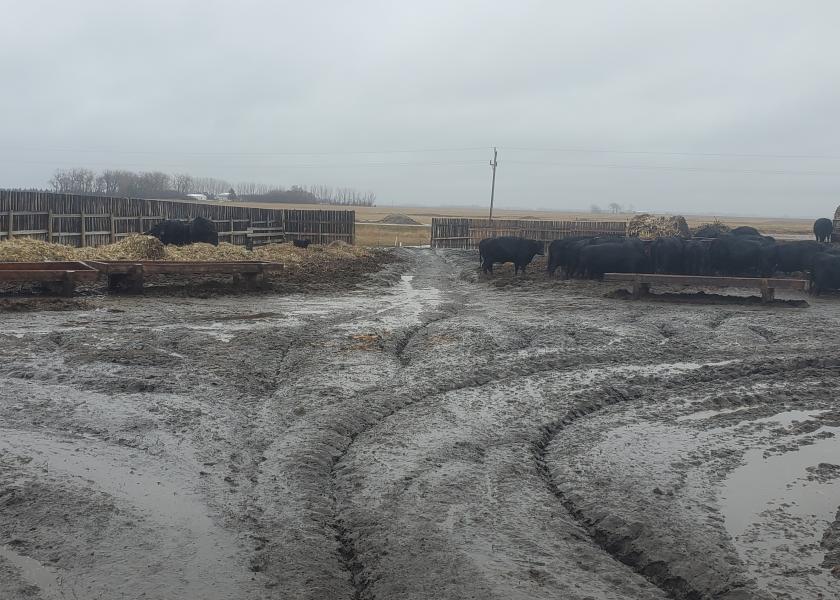Beware of Mud Season

Snow melt, rain and cattle create a recipe for muddy feedlots. While leading to uncomfortable conditions for ranchers, mud is stressful to livestock. Just a few inches of mud requires extra effort for cattle to walk and may lead to a loss of production or weight gain, according to North Dakota State University Extension specialists.
As mud depth increases to between 4 to 8 inches, feed intake can decrease up to 15%. When mud is up to 24 inches deep, feed increase can decrease up to 30%. The effects of mud on performance are especially profound when bedding is unavailable.
“Providing more space for cattle in pens will reduce the depth of mud that cattle tromp up,” says Karl Hoppe, Extension livestock systems specialist. “When extra space is not available, bedding can be used to reduce the effect of mud. Two pounds of bedding per animal is needed to overcome 2 inches of mud.”
Research at the NDSU Carrington Research Extension Center found benefits by bedding at 2 to 2.5 pounds of straw per head per day. Bedding reduced cost of gain and increased marbling score in fed cattle. Mature cows and bulls may need 5 pounds of bedding per day to find comfort.
“When dealing with mud, an alternative to bedding is concrete, Hoppe says. “Heavy-use concrete pads, barns with indoor concrete floors, or completely concreted pens are effective but expensive options. Cleaning concrete pens regularly is recommended, but this can be difficult during winter with frozen bed packs.”
In addition to performance loss, cattle may also experience health issues due to mud.
When cattle get wet, their hair lies down, and they lose insulation value. Mud will further reduce the insulation value of hair coats. Cattle become chilled more quickly from wet and muddy conditions. This stress can inhibit the immune system, making animals more susceptible to disease, says Dr. Gerald Stokka, Extension veterinarian and livestock stewardship specialist.
Mud and manure carry bacteria and other pathogens that can affect cattle health. Calves are particularly susceptible through direct contact or through mud on dirty udders. Calves consuming mud or drinking from mud puddles are at risk for digestive tract infections, such as scours.
Calves born in wet, muddy conditions are also more susceptible to naval/joint infections. Dr. Stokka advises dipping the naval after birth with a sanitizing liquid. A classic product is 7% tincture of iodine, freshly made and uncontaminated.
In muddy conditions, move bunks and bale ring feeders to dry ground regularly. If footing around feeders becomes deep with mud, cows have a better chance of getting dirty udders. If moving feeders is not possible, use bedding materials around feeders to keep footing as dry and clean as possible.
Foot rot can also be an issue with muddy conditions. The bacteria responsible for foot rot persist in wet areas. The skin between the toes become tender in wet conditions, leading to increased risk of an opened wound and infection.
“It is often difficult to do anything about mud when there are limited areas of dry ground,” Dr. Stokka says. “Anything that can be done to minimize mud can help decrease the incidence of health issues. During calving, periodically move cows waiting to calve to the driest ground possible, or add bedding for the cattle.”
Few options are available after muddy conditions are in place; therefore, preventive practices are key. Extension forage crops production specialist James Rogers offers these recommendations to aid in reducing muddy conditions:
• Scrape lots to maintain a 3% to 5% slope away from the feed bunk.
• Reshape mounds to ensure quick drainage.
• Move livestock to temporary feeding areas such as stockpiled pastures with adequate drainage or fields containing crop residue such as corn stalks.
• If stockpiled pastures are not available, consider moving livestock to pastures with tame grasses, such brome, crested wheatgrass or old CRP that is better able to withstand the impact of early grazing.
• If tame pasture is not an option, then consider native pastures that have Kentucky bluegrass as a dominant species to reduce potential negative impacts to the growth of native grass species.
“Be aware of the potential for soil compaction when placing livestock in saturated crop fields in the spring and the potential for challenging planting conditions,” Rogers adds.
Mud will likely be an issue for farms and ranches when spring arrives. Taking precautions now should help reduce performance loss and improve cattle health.







